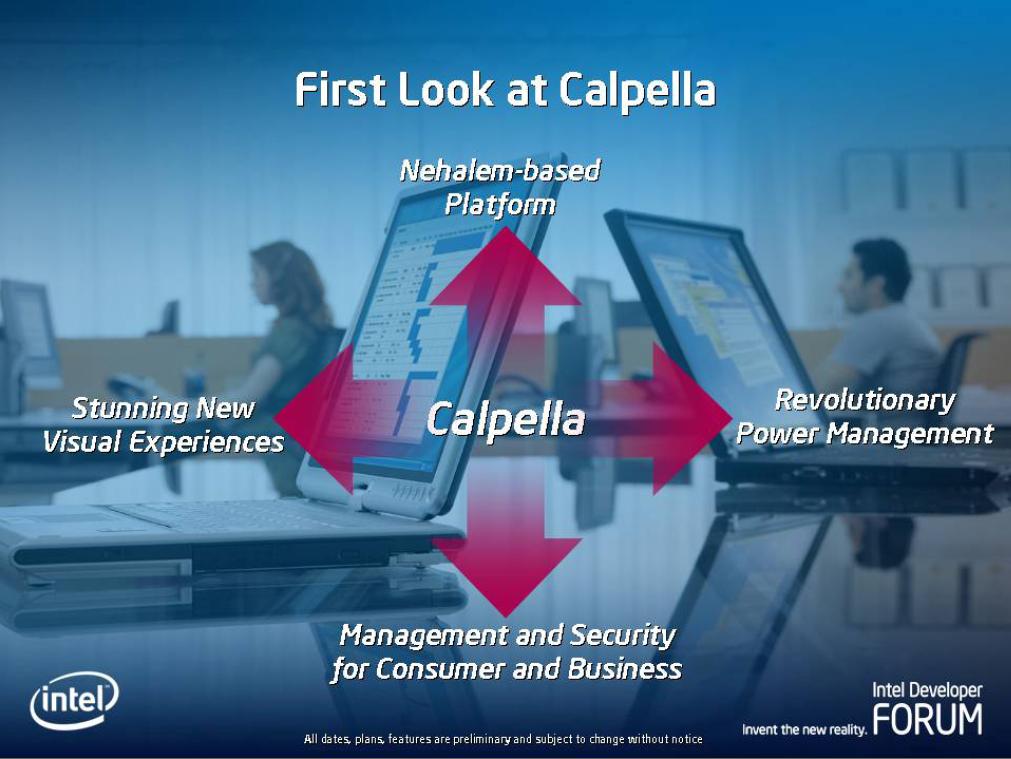Beyond Centrino 2: what's next for laptop tech?
Intel is already cooking up the next generation

Shhhh! You may already own a shiny new Centrino 2 laptop, but Intel is already cooking up the successor, code-named Calpella (named after a small town in California). Details are sketchy, but we poked and prodded Intel until they coughed up a few tidbits. And, just his week, tech gossip rag The Inquirer drudged up some rumours and speculation that we, of course, need to perpetuate.
For starters, Intel passed on some information from a keynote that the vice president and general manager of its mobility group, Dadi Perlmutter, mentioned at Shanghai IDF (Intel Developer Forum) in April.
Tick Tock generation
"Calpella is going to feature a new microprocessor, the next generation coming out from the Intel Tick-Tock Factory, coming to mobile next year, together with the stunning new computing visual experience, better manageability, better security for consumer and the business, and last but not least, evolutionary power management," said Perlmutter during his keynote.
"We are going to feature new power management capabilities on Calpella that are really playing between the power of a CPU and graphics and visual computing, so you can get the best performance still not burning your laps."
That's all well and good, but also a little generic. So we asked one of the foremost chipset analysts around today to explain what it means, and to frame it in more practical terms.
Nehalem will change
Sign up for breaking news, reviews, opinion, top tech deals, and more.
"Nehalem (recently unmasked for the desktop as Core i7)will significantly change the architecture of Intel's processor because all versions will integrate the main memory controller onto the same die with the CPU, and most mobile versions will integrate a graphics processor on the same die with the CPU, too," says Shane Rau, a research director for computing, networking, and storage semiconductors at IDC.
"It's using the same code-name for processors in the x86 server and desktop PC segments. The effect will be to gut the major functions of part of the core logic chipset called the Northbridge. As a result, core logic chipset vendors who rely on the chipset market for their business will be severely undercut."
In other words, watch out Nvidia and AMD/ATI. Intel intends to solve the power and performance bottlenecks of modern day processors by combining the CPU and GPU. And there's another way to interpret the change. Intel wants to move farther away from a "component" mentality to laptop computing, the strategy that AMD has been using for years.
Group of Pumas
Its Puma platform for notebooks, for example, is more of a group effort, says Rau, and even integrates a third-party wireless chip from Broadcom. Today, AMD has segmented its offerings for "thin and light" or "desktop replacement" but the Intel strategy is pretty much: a chipset inside any laptop, no matter which shape and size.
Meanwhile, The Inquirer report mentions this same "conjoining" of the CPU and GPU – and covers how Intel plans to integrate the Southbridge section of the chipset onto the Northbridge section, including the DDR3 memory controller.
However, they go a step further and explain that a new chipset, codenamed Ibex Peak-M, will integrate "other features" of the motherboard (we can only imagine what they would be), and that the next mobile chipset after Centrino 2, which maybepredictablynamed Centrino 3, will also provide both 802.11n Wi-Fi and Wi-Max on the same chipset. The new notebook codenames, Clarksfield and Auburndale, will integrate graphics onto the chipset, according to The Inquirer report.
Step back
But let's take a step back. What we know for sure, based on Perlmutters' comments, is that Centrino 3 will push the envelope even further on battery management, graphics performance, and security.
Centrino 2 integrates 802.11n Wi-Fi (for over 100Mbps of throughput) and Wimax (for citywide wireless deployments that require fewer towers to cover a large area) on the same chipset, making it ready for prime time once those technologies become more ubiquitous (read: are not stalled out by company failures, low adoption rates, and certification snafus). We also know that Centrino 2 was delayed for about six weeks by a graphics glitch, which is – it should be noted – not a good sign.
Wikipedia, always the bastion of certifiable hard-core facts, also has some Capella details, but none of them include citations: that Calpella will use the Intel QuickPath Interconnect and not use the frontside bus; support for DisplayPort with DPCP; RAM support up to DDR-1600 SO-DIMM; and SSD support.
The Wikipedia entry even claims that Calpella will "premiere" in Q3 2009, a word that sounds like it was written by an Intel marketing spokesperson, likely the same individual who told us by email that Intel could not elaborate any further on Calpella details or confirm any release dates.

John Brandon has covered gadgets and cars for the past 12 years having published over 12,000 articles and tested nearly 8,000 products. He's nothing if not prolific. Before starting his writing career, he led an Information Design practice at a large consumer electronics retailer in the US. His hobbies include deep sea exploration, complaining about the weather, and engineering a vast multiverse conspiracy.